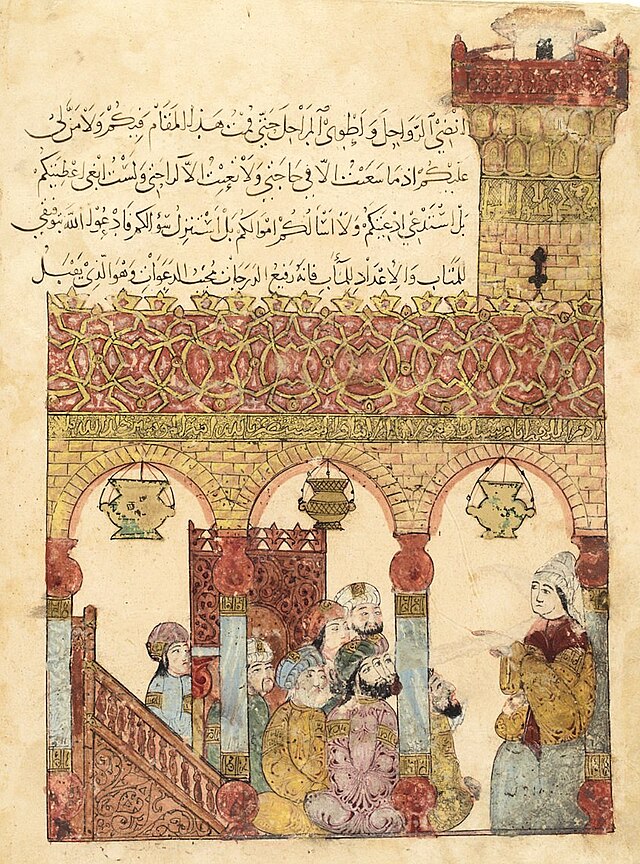Al-Mustansir I
36th and Penultimate Abbasid Caliph (r. 1226–1242) From Wikipedia, the free encyclopedia
Abu Ja'far al-Mansur ibn al-Zahir[a] (17 February 1192 – 2 December 1242), commonly known as al-Mustansir I,[b] was the 36th Abbasid caliph, ruling from 1226 to 1242. He succeeded al-Zahir as caliph in the year 1226, and was the penultimate caliph to rule from Baghdad. He was the second-to-last caliph of the Abbasid Caliphate.
| Al-Mānsūr al-Mustansir bi-llah المنصور المستنصر بالله | |||||
|---|---|---|---|---|---|
| Khalīfah Amir al-Mu'minin | |||||
 Dirham of al-Mustansir | |||||
| 36th Caliph of the Abbasid Caliphate Abbasid Caliph in Baghdad | |||||
| Reign | 10 July 1226 – 5 December 1242 | ||||
| Predecessor | al-Zahir | ||||
| Successor | al-Musta'sim | ||||
| Born | 17 February 1192[1] Baghdad, Abbasid Caliphate, (now Iraq) | ||||
| Died | 5 December 1242 (aged 50) Baghdad, Abbasid Caliphate | ||||
| Burial | Baghdad | ||||
| Consort | Shahan Hajir[2] | ||||
| Issue | Al-Musta'sim | ||||
| |||||
| Dynasty | Abbasid | ||||
| Father | al-Zāhīr | ||||
| Mother | Zahra | ||||
| Religion | Sunni Islam | ||||
Biography
Summarize
Perspective

Al-Mustansir was born in Baghdad on 1192. He was the son of Abu Nasr Muhammad (future caliph al-Zahir). His mother was a Turkish Umm walad.[4][5] called Zahra. His full name was Mansur ibn Muhammad al-Zahir and his Kunya was Abu Jaʿfar. At the time of his birth, his father was a prince. When his father ascended to the throne in 1225. His father, lowered the taxes of Iraq, and built a strong army to resist invasions. He died on 10 July 1226, nine months after his accession.
On his father's death in 1226 he has succeeded his father Az-Zahir as the thirty-sixth Abbasid caliph in Baghdad. Al-Mustansir is particularly known for establishing the Mustansiriyya Madrasa (currently a part of the Al-Mustansiriya University) in 1227/32/34. The Madrasa, at the time, taught many subjects including medicine, mathematics, literature, grammar and Islamic religious studies, becoming a prominent and high-ranking center for Islamic studies in Baghdad.[6]
The Madrasas during the Abbasid period were used as the predominant instrument to foster the spread of Islamic thought as well as a way to extend the founder's pious ideals.[7]

The ruler of Erbil, Muzaffar ad-Din Gökböri was being without a male heir, Gökböri willed Erbil to the Abbasid caliph al-Mustansir.[8] After the death of Gökböri in 1233, the Erbil city came under Abbasid control.
Al-Mustansir died on 5 December 1242.[9] His son Al-Musta'sim succeeded him as the thirty-seventh and last Caliph of the Abbasid Caliphate.
Family
One of Al-Mustansir's concubines was Shahan. She was a Greek, and had been formerly a slave of Khata Khatun, the daughter of the commander Sunqur al-Nasiri the Tall and the wife of the commander Jamal al-Din Baklak al-Nasiri. After Al-Mustansir's accession to the throne, Khata presented Shahan to him as a gift, as part of a group of slaves. Shahan alone among them became his concubine and favourite.[10] Another of his concubines was Hajir. She was the mother of the future Caliph Al-Musta'sim.[11]
See also
- Sixth Crusade (1228–1229), a military expedition to recapture the city of Jerusalem from Muslims.
Notes
References
Sources
Wikiwand - on
Seamless Wikipedia browsing. On steroids.
